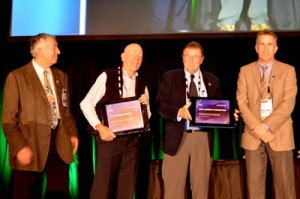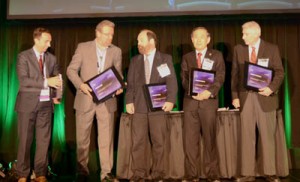If you walk through the crowds this year, you know the symposium is well attended. We have about 50 less papers this year than last, but about the same number of attendees – on the order of 1,700 technical attendees and another 800 or so who just come to the exhibits. Short course attendance was up about 25% from last year. A very healthy and dynamic conference.
We began our first day with the awards ceremony, and a very rare “career achievement” award. Andy Neureuther and Bill Oldham were acknowledged for their “career long contribution to the art and science of lithography” through their lithography modeling efforts at the University of California at Berkeley. Andy was a co-author of some of the original 1975 Dill papers (the most famous papers in lithography, in my opinion) and Andy and Bill, along with their students, published the SAMPLE simulator in 1979. Their SAMPLE group made numerous important contributions to lithography over the last 35 years, and of course the many great students they have graduated continue to multiply their influence. As Symposium Chair Mircea Dusa said, this work was a “defining moment, when lithography went from an art to a science.” The award was made “in deep appreciation for your 40 years of visionary guidance and dedication to SPIE society and lithography community.” Congratulations Andy and Bill!
Ralph Dammel, CTO of AZ Electronic Materials, was the recipient of the 12th Frits Zernike award (full disclosure – I nominated him). I learned a tremendous amount from Ralph’s 1993 book on DNQ/Novolac resists, and learned to appreciate sweetbreads and German coffee when I visited him in Frankfurt about 25 years ago. A well-deserved award (for the lithography, not the sweetbreads).
We have five new Fellows of SPIE in our community as of Monday: Luigi Capodieci, Bernd Geh, Moshe Preil, Masato Shibuya, and Obert Wood. GlobalFoundries almost swept the ranks! Congratulations to all of you.
The plenary session was a mixed bag. Alan Willner gave a nice overview of the National Photonics Initiative, an “alliance” of industry, academia, and government that includes SPIE and that began in 2012. The goal of the NPI is to drive US investment in photonics (read: get the US government to spend more on photonics). Photonics, like many fields of science that border technology, seems to have a case of Moore’s Law envy.
The talk by Tsu-Jae King Liu of UC Berkeley was one of the best plenaries ever. With power as the current limiter of CMOS performance scaling, she proposed a couple of very innovative solutions. The use of micro-relays was especially intriguing. I’ll be following developments in that field going forward.
I have been out of corporate America too long to appreciate Xiaowei Shen’s final plenary talk on the “internet of things”. It was so full of IBM-speak that I could barely understand it.
When the regular conference talks began at 11am I had the familiar problem of wanting to be in multiple places at the same time. I missed more worthy talks than I attended. Gerg Yeric of ARM showed me how little I know about design-manufacturing interactions and how hard scaling is getting independent of lithography. He noted that when we shrink, some of the SRAM cells in logic designs are moving from 6 transistors to 8, 10, or even 18 transistors to store one bit in order to keep the cells both fast and reliable in the face of variability. It makes you wonder if cost per transistor is a useful metric to assess the value of shrinking.
Changmoon Lim of SK hynix gave a talk on challenges for EUV insertion into high-volume manufacturing (HVM), a perennial topic at this conference. The Hynix experience on the NXE:3100 EUV tool from ASML was about slow learning. The tool was installed in the summer of 2011 and over three years the throughput went from 2 wafers per hour (WPH) to 7 WPH, and tool availability went from 25% to 75%. Learning is picking up with the installation of their NXE:3300, though he gave little data. A 2xnm generation DRAM split lot with one layer printed on EUV produced comparable yield to 193i, but they had to use an exposure dose much higher than the goal of 20 mJ/cm2 to achieve that yield (when I asked, he wouldn’t tell me the exact dose used).
I missed Tony Yen’s talk about EUV progress at TSMC – I was busy giving a talk of my own. I’m told he described the very fast progress that source power has made in the last year, going from 20W to 40W, and more recently to 80W, installed on a TSMC tool. I also missed Todd Younkin of Intel and the idea of bottoms-up growth of metal vias next to cuts filled with dielectric to improve overlay. He told me later than much work remains on this idea, but it sounds very promising.
Toshiaki Ikoma, CTO of Canon, gave an overview of their new nanoimprint lithography (NIL) tool, claiming the tool was “now available” and that Canon “will be back to the leading lithography company again.” We’ll have to wait and see. And we’ll have to wait to see the data that support these claims during other NIL talks this week.
The day ended with a panel discussion on the metrology challenges of 3D devices. I was on the panel, but since I know nothing about the metrology challenges of 3D devices, I gave a speech on a different topic. You can find my speech here: http://www.lithoguru.com/scientist/essays/Metrology.html.
A general complaint about panel discussions: the standard format that we almost always use doesn’t work. We should abandon it. This format involves posing a number of momentous and difficult questions, and telling each panelist to prepare a 5 minute talk on those questions. Of course, the panelists use powerpoints (most of us are barely able to talk without powerpoint, and I suspect the audience is barely able to listen without powerpoint as well), and each one averages 10 minutes. Our scheduled 90 minute panel had only 30 minutes of audience questions at the end, but that was only because we went 20 minutes over the allotted time. Through no fault of the fine panelists on stage with me, it was a truly boring experience. How can we make panels better? Give the panelists at most one minute (and no slides) to make an introductory statement, or better yet no introductory statement. Then go right into questions, alternating between moderator and audience questions. Make sure it is fun, and not a mini conference session. Also, beer helps.
My favorite quote of the day: “Double patterning was thought to be a bridge between immersion and EUV, we just didn’t realize how long the bridge would be.” – Changmoon Lim, SK hynix



